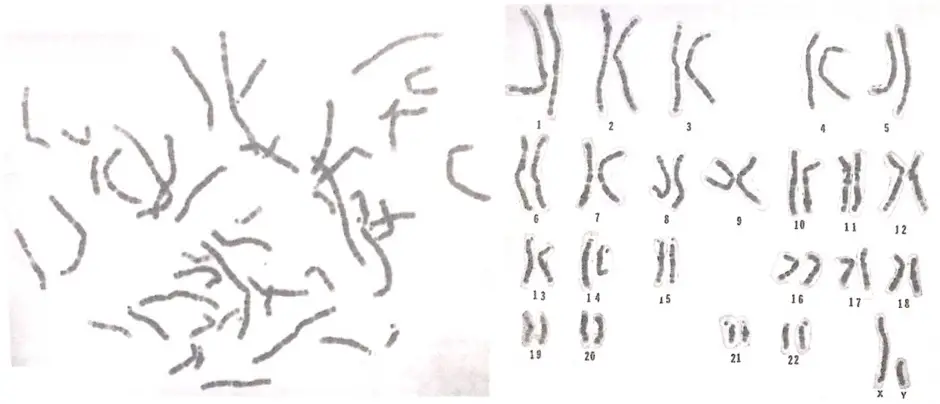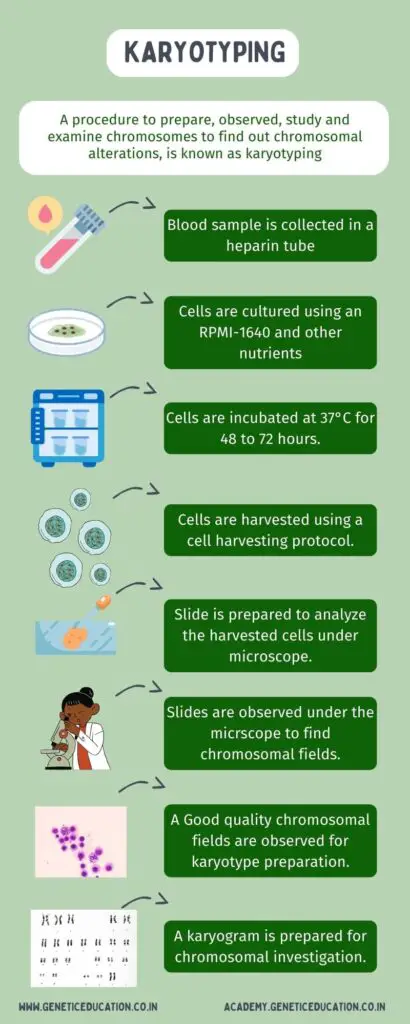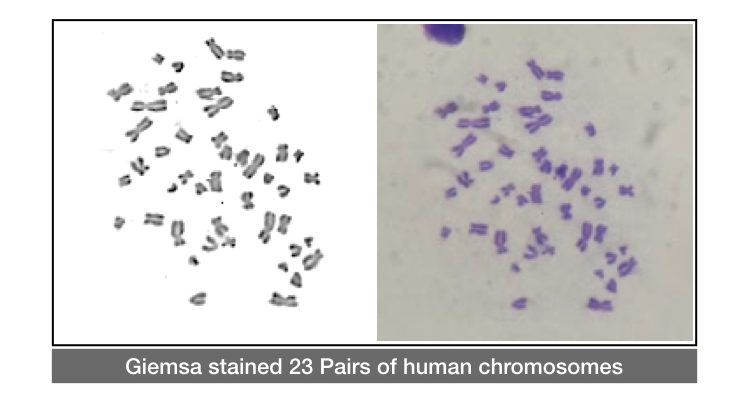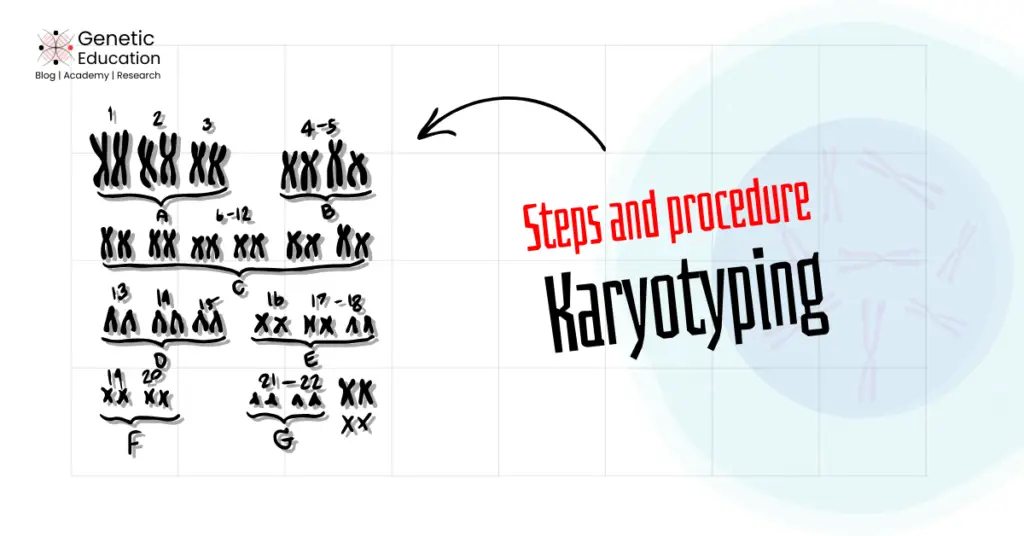“Steps in karyotyping are sample collection, cell culture, metaphase preparation, hypotonic treatment, staining and banding, microscopy and analysis.”
Which is the most primitive, earliest and old-school genetic technique that is still in use?
Let me tell you, it is still a gold-standard method in the diagnosis of genetic disorders– karyotyping! A technique to investigate chromosomes and chromosomal constituents.
Originally developed to study plant chromosomes, the present method is used to study numerical and structural* chromosomal anomalies.
In the era of PCR and NGS and despite having limited resolution, karyotyping is still in use. Let’s learn karyotyping, what it is, how it is done and steps & procedure.
Stay tuned!
Disclaimer: The content presented herein has been compiled from reputable, peer-reviewed sources and is presented in an easy-to-understand manner for better comprehension. A complete list of sources is provided after the article for reference.
Key Topics:
What is Karyotyping?
The word karyotyping was derived from the ancient Greek word “Karyon” which means “Kernel”, “seed” or “nucleus”. Chromosomes were first observed in plants thus the name karyotype is given to it.
In 1842, Carl Wilhelm von Nageli observed the plant cell nucleus. He observed a thread-like structure and named it transitory cytoplasts which were actually chromosomes.
In 1888, Waldeyer named Nageli’s findings as chromosomes. Read a short history of cytogenetics here: History of cytogenetics.
In 1956, Tjio JH, Levan found 46 numbers of human chromosomes. Human chromosomes are in pairs. Among a total of 23 pairs, 22 pairs are autosomes while a single pair is sex chromosomes.
Note that chromosomes are a complex network of DNA & proteins containing all the nuclear DNA. Any change in the number or structure of chromosomes results in genetic abnormalities.
Karyotyping is the conventional cytogenetic technique, used to study such alterations. Notedly, it can not study DNA or sequence-level alterations.

Definition:
“A procedure to study, observe and examine chromosomes aiming to find related alteration is known as karyotyping.”
Steps & Procedure:
Unlike other genetic techniques, karyotyping is a complex, tedious, sensitive, error and contamination-prone technique. Interestingly, it relies on the conventional cell culture procedure.
Standard cell culture procedures are followed for metaphase harvesting. Afterward, using a chemical treatment, chromosomes are separated and observed under the microscope.

Steps:
The complete procedure is divided into 7 different steps– Sample collection, cell culture, metaphase preparation, hypotonic treatment, staining & banding, microscopy and analysis.
Sample collection:
Sample collection is the first and crucial step in karyotyping. Keep in mind that the sample must proceed within 24-48 hours to achieve cell culture. Common sample types are blood, amniotic fluid, chorionic villi, tissue or biopsy, cord blood and bone marrow.
Here is the table for the sample type, their collection tube and storage and transport conditions.
| Sample | Container | Storage; transport conditions |
| Whole blood | Heparin tube | 4ºC; 24 hours |
| Amniotic fluid | Sterile screw cap tube | 4ºC; 24 hours |
| Chorionic villi | Sterile culture media or transport media tube | 4ºC; 24 hours |
| Tissue or biopsy | Culture media tube | 4ºC; 24 hours |
| Cord blood | Heparin tube | 4ºC; 24 hours |
| Bone marrow | Heparin tube | 4ºC; 24 hours |
Cell culture
After sample collection, now it’s time to culture the cells. First, follow all the lab safety and sterility protocols to achieve good results.
For cell culture, we use complete media like RPMI-1640 including antibiotics, L-glutamine or phytohemagglutinin M and other amino acids. Culture media can also be prepared manually but is a time-consuming and contamination-prone process.
The culture media ingredients and their function are explained in the table below,
| Chemical | Function |
| RPMI-1640 | Cell culture growth media |
| L-glutamine | Essential amino acid |
| Antibiotics | Prevent bacterial contamination |
| Colchicine | Prevent spindle fiber formation |
| EtBr | Release condensation of chromosomes |
| Methanol | Used as a fixative in harvesting |
| Glacial acetic acid | Used as a fixative in harvesting |
| PHA-P | Mitotic stimulator- promotes cell division |
| Hypotonic solution | Cell swelling |
| Giemsa | Staining and banding |
The mixture of sample and culture media is incubated in the incubator for 72 hours.
Related article: Role of L-Glutamine In Karyotyping.
Metaphase preparation
The metaphase contains well-spread, organized and distinctly-looking chromosomes. So it is mandatory to arrest all the cells in the cell culture at the metaphase stage.
How can we do that?
A chemical known as colchicine or colcemid is added into culture tubes. It prevents metaphase spindle fiber formation. Resultantly, cells can not progress in the cell cycle. We will get good-looking and well-separated metaphase chromosomes.
Hypotonic treatment
Chromosomes are very tightly packed inside the cell nucleus. In order to study it, we need to separate them from cells. To do so, we give hypotonic treatment. This process swells the cells.
When we drop the cell suspension on the slide, the cell can easily burst and chromosomes are separated. KCl is used for the hypotonic treatment.
Cell harvesting
Cell harvesting is a procedure in which we remove all the cellular debris except the chromosomes from the suspension. This step is not contamination-prone so can be performed in the normal lab space.
Methanol and glacial acetic acid are used for cell harvesting. Repeated fixative washes and centrifugation helps achieve excellent purity.
Note:
Harvesting is performed until clear and white pellets appear.
Slides preparation
Now! To observe chromosomes under a microscope we need to prepare the slide. It follows the same scheme of slide preparation as other standard procedures with a minor variation.
Here we drop the cell suspension from 2 feet. This will break cells and separate chromosomes.
The slide is pre-chilled in the methanol so that once the cell suspension hits the slide; it is immediately fixed. In the next step, we need to stain the slides and also need to perform bandings, so we prepare slides in bulk.
Note that slides are not covered with a coverslip. After drying, store the slides in a clean container.
Staining and banding
Before preparing the karyogram, we need to validate whether everything worked properly or not! Meaning, cells are arrested on the metaphase? Chromosomes are separated? Or so on.
First, we need to perform staining. One slide is stained with the conventional Giemsa stain. Stained chromosomes appear blue and have thread-like structure. Check out the image.

Once we validate the results, now! It is the time to perform various banding techniques to study, observe and examine various abnormalities. GTG (giemsa-trypsin-giemsa) is the common and routine banding technique performed first.
G-banding: Giemsa-Trypsin-Giemsa banding is implemented to know numerical and structural chromosomal variations.
Here the trypsin digests the protein portion of chromosomes, and Giemsa stains the loosely packed regions as dark blue which collectively gives light and dark color patterns to various chromosome regions.
The heterochromatin regions stained dark and euchromatin regions stained light.
Q-banding: The Q-banding name is given by the use of quinacrine fluorescent dye in the banding technique. The present method is similar to G-banding, however, here the fluorescent dye is utilized instead of a normal dye.
Here the quinacrine binds to the AT-rich heterochromatic region and emits yellow color fluorescence. Due to this distinct banding pattern, chromosomes are seen under the fluorescent microscope.
C-Banding: C-banding is a variation of G-banding that only stains the centromeric regions of the chromosomes thus the name is given. However, the entire process of getting the C-banding is different from conventional G-banding. We will talk about it in some other article.
R-banding: R-banding or reverse banding is the inverse method of G-banding in which instead of heterochromatin regions, the euchromatin regions appear darker and vice versa.
NOR-banding: The NOR-banding or nucleolar organizing region is a silver staining method majorly used to detect acrocentric chromosomes.
T-banding: A less popular banding method is T-banding which is used to study the telomeric regions of chromosomes.
Microscopy
Stained and banded slides are observed under the microscope. Note that high-resolution microscopy is required to observe the results. Observation can be started with 10X, after spotting the metaphase, observe under 45X.
To identify abnormality, we use a 100X/oil immersion lens. 50 to 100 well-spread metaphases are targeted and observed. After the completion of the metaphase analysis, the camera captures the images.
Results and analysis:
Now, using software or manual investigation, results are analyzed. First, all the chromosomes are counted. Then, they are paired and after that used to identify abnormalities like deletions, duplications or translocations.
Noteworthy, extensive experience and expertise are needed to perform and observe karyotypes.
Procedure:
- Sample collection in the respected container, for instance, whole blood in the heparin tube and transferred to the lab.
- 0.1ml blood is taken and cultured in the complete culture media.
- Cell culture is incubated in the incubator for 72 hours.
- At the 71th hour, colchicine is added to the culture. EtBr is sometimes added. It is believed that it enlarges chromosomes.
- Culture is harvested using the standard solution of methanol and glacial acetic acid repeatedly until clear pellets appear.
- Cells are treated with the hypotonic solution.
- Slides are prepared from the solution and used for staining and banding.
- Slides are observed under the microscope for anomaly investigation.
To know more about the complete protocol, ingredients quantity and concentration, you can read or download our standard peripheral blood lymphocyte culture.
Applications:
As aforementioned, karyotyping is still a gold-standard method in plant research, diagnosis and prenatal genetic screening. Here we listed some crucial applications of karyotyping.
Detecting genetic abnormalities:
The present method is widely used in screening, identifying and detecting genetic abnormalities associated with chromosomes. These abnormalities are either numerical or structural.
For instance, numerical and structural conditions like Down syndrome (Trisomy 21) & Turner syndrome (Monosomy X) and Philadelphia chromosome (translocation) and 5p deletion can be investigated, respectively.
Prenatal diagnosis:
Karyotyping is extensively used in prenatal diagnosis to evaluate chromosomal abnormalities. Amniotic fluid or chorionic villi sample is cultured to reveal the chromosomal profile of the fetus. Prenatal karyotyping helps in early diagnosis and guide pregnancy management.
Recent advancement as cell-free fetal DNA testing is a safer alternative to amniocentesis and reduce fetal-loss risk.
Cancer research and studies:
Structural chromosomal abnormalities are common cancer markers. Various deletions, duplications and translocations are associated with various types of cancer. For cancer studies, karyotyping is a mandatory primary step for screening.
Here is a table of common cancers and associated chromosomal abnormalities.
| Cancer type | Chromosomal abnormality |
| Chronic Myeloid Leukemia (CML) | Philadelphia chromosome (t(9;22) translocation) |
| Retinoblastoma | Deletion on chromosome 13q |
| Neuroblastoma | MYCN gene amplification (duplication) on chromosome 2p |
| Burkitt Lymphoma | t(8;14) translocation |
| Wilms Tumor | Deletion on chromosome 11p |
Determining genetic sex:
By looking into the fetus’s karyotype, fetal sex can be determined. In humans, females have two X chromosomes while males have one X and a Y chromosome. Scientists karyotype the fetal sample and look for X and Y chromosomes to reveal the sex.
Infertility assessment
Structural chromosomal abnormalities like balanced and unbalanced translocations are commonly observed in infertility and recurrent miscarriages. To investigate these problems, the doctor advised to go for karyotyping first.
Genetic research:
Karyotyping is also employed for plant, human and animal research. For instance, in plants, it is used to study polyploidies and aneuploidies during the experiments. By doing so, scientists can investigate the harmful and helpful traits.
Furthermore, it is also employed for telomere and aging research and centromeric instability and related research activities.
Advantages and Limitations
| Advantages | Limitations |
| Detects major chromosomal abnormalities | Low resolution for small mutations |
| Useful in prenatal and cancer diagnosis | Time-consuming process |
| Provides a complete chromosome overview | Requires viable, dividing cells |
| Aids in infertility analysis | Not suitable for mosaicism detection |
| Strict aseptic conditions are required | |
| Prone to contamination and failure | |
| Extensive expertise and experience is needed. |
Recent advancements in Karyotyping
Karyotyping has limited resolution, yet it remains irreplaceable. However, recent advancements like spectral or digital karyotyping, FISH and microarray made it even more powerful and high resolution.
Spectral karyotyping:
Spectral karyotyping is a digital form of standard karyotyping. Here, all the chromosomes are labeled with different colors. Whole chromosome-specific probes with 5 different dyes are used.
Dye will interact and produce different colors for different chromosomes. Now, this method provides ease in numerical chromosomal investigations.
In addition, cryptic chromosomal changes and particularly the balanced translocations can be effectively identified using spectral karyotyping. Notwithstanding, it has a resolution of >5Mb, smaller alterations than this can not be studied.
FISH:
FISH- Fluorescent In Situ Hybridization is another advanced version of karyotyping, we can say. Using sequence-specific FISH probes various alterations associated with genetic disorders, particularly cancer can be investigated.
To know more about FISH click the link and read the article.
Microarray:
Microarray is another advanced and latest version, considered as a molecular cytogenetic technique. Chromosomal microarray can investigate alterations associated with all the chromosomes from the genome.
In this technique, sequence-specific probes are immobilized on the solid surface and allowed to hybridize with the denatured chromosomal DNA. The results are investigated using computer software.
It has a resolution lower than 5Mb and can study thousands to millions of alterations in a single experiment. To know more about microarrays click the link and read the article.
Related article: Gene Expression Microarray: Principle, Process, Advantages, Limitations and Applications.
Wrapping up:
In conclusion, karyotyping continues to play a valuable role in genetic research and diagnosis and will remain beneficial in the future. However, its lower resolution and labor-intensive process may limit its widespread application.
I know many laboratories that process hundreds of karyotyping samples in a day or week. That’s huge! Isn’t that? Once you have experience and a standard operating system, it is easy to perform karyotyping.
Moreover, recent advancements such as automation in analysis and state-of-art microscopy instruments have made the process easier and increased throughput in karyotyping.
I hope you like this article. Share it and subscribe to Genetic Education.
Sources:
Bates SE. Classical cytogenetics: karyotyping techniques. Methods Mol Biol. 2011;767:177‐190.
Schreck RR, Distèche C. Karyotyping. Curr Protoc Hum Genet. 2001; Appendix 4.



Thank you for sharing this article post.Really looking forward to read more